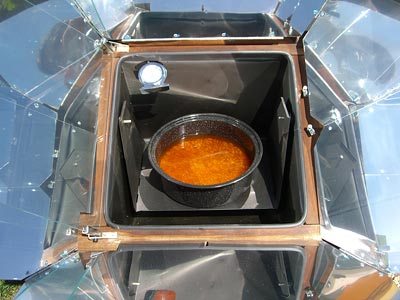Solar Cooking Helpful Hints…It’s Easy!

Spring is here! That means the nicer weather is also here. Time to start using the solar oven. We have gotten so many nice responses to Ken’s recent solar oven post, I thought I’d elaborate some more and share with you some of my tips.
First of all, using a solar oven is very easy. Don’t be afraid of trying one. Think of it as though it’s a really big crock pot or slow cooker. It would be really hard to mess up a meal. I recommend that if you are new to solar cooking, begin with weekend (or your days off from work) cooking. Trying different foods, different pans, different oven locations in your yard, different oven angles, as well as different times of day, will give you the confidence you need to use a solar oven. Really, after using it once or twice, you should be a professional. They are easy and convenient to use.
The simplest tip is to use a black pan, which will absorb the sun’s heat quicker. Another tip is to cover the pan, and use a black cover (lots of normal pots or pot covers are not black so you may have to look specifically for one that fits your solar oven).
Another tip, which may seem obvious, is to be sure the oven is facing the sun in not only the direction, but also the tilt. Solar ovens are each different in how they are designed to point towards the sun.
Another tip is to use an oven thermometer that sits inside the solar oven. Some already come with one, but they are easily available.
Yet another tip is to be aware of the weather or weather forecast. If the day is forecast to be mostly cloudy, you will not have much success. Stands to reason.
Ken is right in saying that the best baked potatoes we’ve ever had are the ones that we cooked in the solar oven. They come out so moist and delicious. This was especially true with the older homemade solar ovens that we’ve had which didn’t get real hot (up to about 250). We used to put them in the oven mid morning on a weekend and they’d be ready at dinner time. And you don’t really have to worry about over cooking. Because it’s a slow cooker, it’ll be really hard to burn something.
One thing to mention is that the Global Sun Oven, the one we have now, is really efficient. And that means that if you keep it lined up with the sun, it will get quite hot inside, as high as 375 degrees. If you have a cloudless day during the time of year when the sun is high, you need to treat the Global Sun Oven more like a real oven than a slow cooker. One way to sort of turn it in to a slow cooker is to allow the sun to drift out of the direct angle of the oven, or purposely adjust the angle of the oven off somewhat until the temperature is what you want inside. There is a thermometer in this model (you can easily buy your own too), which helps you decide how long to cook.
We have made various types of roasts, corn on the cob, salmon fillets, breads and cupcakes, and much more…all in the solar oven. We put a small amount of water on the bottom of the pan when cooking just about anything (except breads). So, for example, if you’re making a roast, put about 1/2 inch of water on the bottom of the pan, place your roast inside and add the seasonings you like. For us, a lot of times, I simply wedge cut an onion and put that in there. It is obviously important to cover the pan or the moisture will escape. The flavor of the very moist meat will seem better than a conventional oven. Or, maybe it is something to do with the psychological effect of how we often think food tastes better when camping, etc. :)
After some practice, you will know how long it takes to cook certain items. Sometimes you may need to move your oven from one side of the yard to the other in order to follow the sun or to escape the shadow of a tree, etc. My tried and true method to determine if the food is cooked, …stick a fork in it!
Appreciate topics of survival, emergency preparedness – or planning for disaster?
Read our current articles on Modern Survival Blog
twitter: MSurvivalBlog
Facebook
